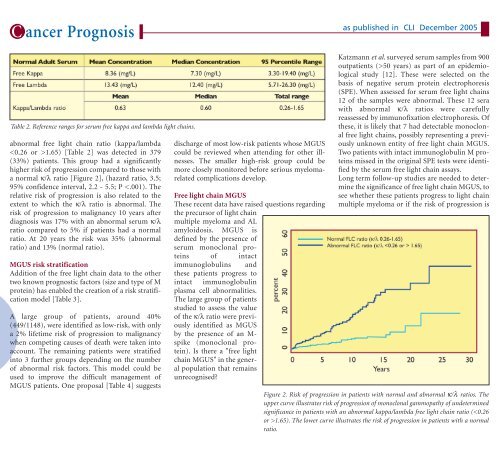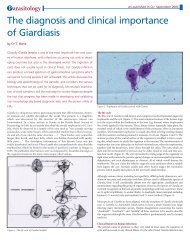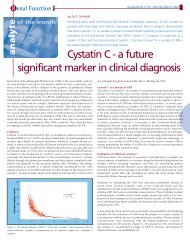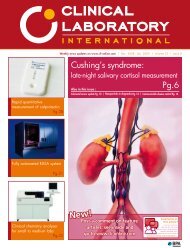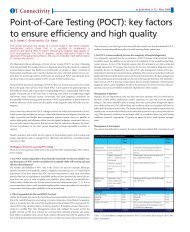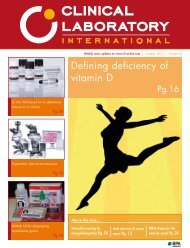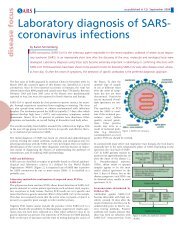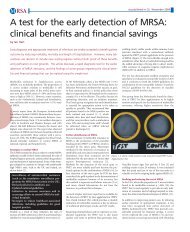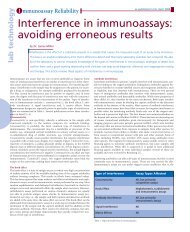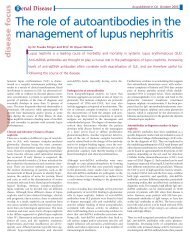Serum free light chain ratio predicts outcome in MGUS
Serum free light chain ratio predicts outcome in MGUS
Serum free light chain ratio predicts outcome in MGUS
You also want an ePaper? Increase the reach of your titles
YUMPU automatically turns print PDFs into web optimized ePapers that Google loves.
C ancer Prognosisas published <strong>in</strong> CLI December 2005Table 2. Reference ranges for serum <strong>free</strong> kappa and lambda <strong>light</strong> <strong>cha<strong>in</strong></strong>s.abnormal <strong>free</strong> <strong>light</strong> <strong>cha<strong>in</strong></strong> <strong>ratio</strong> (kappa/lambda1.65) [Table 2] was detected <strong>in</strong> 379(33%) patients. This group had a significantlyhigher risk of progression compared to those witha normal κ/λ <strong>ratio</strong> [Figure 2], (hazard <strong>ratio</strong>, 3.5;95% confidence <strong>in</strong>terval, 2.2 - 5.5; P 50 years) as part of an epidemiologicalstudy [12]. These were selected on thebasis of negative serum prote<strong>in</strong> electrophoresis(SPE). When assessed for serum <strong>free</strong> <strong>light</strong> <strong>cha<strong>in</strong></strong>s12 of the samples were abnormal. These 12 serawith abnormal κ/λ <strong>ratio</strong>s were carefullyreassessed by immunofixation electrophoresis. Ofthese, it is likely that 7 had detectable monoclonal<strong>free</strong> <strong>light</strong> <strong>cha<strong>in</strong></strong>s, possibly represent<strong>in</strong>g a previouslyunknown entity of <strong>free</strong> <strong>light</strong> <strong>cha<strong>in</strong></strong> <strong>MGUS</strong>.Two patients with <strong>in</strong>tact immunoglobul<strong>in</strong> M prote<strong>in</strong>smissed <strong>in</strong> the orig<strong>in</strong>al SPE tests were identifiedby the serum <strong>free</strong> <strong>light</strong> <strong>cha<strong>in</strong></strong> assays.Long term follow-up studies are needed to determ<strong>in</strong>ethe significance of <strong>free</strong> <strong>light</strong> <strong>cha<strong>in</strong></strong> <strong>MGUS</strong>, tosee whether these patients progress to <strong>light</strong> <strong>cha<strong>in</strong></strong>multiple myeloma or if the risk of progression isFigure 2. Risk of progression <strong>in</strong> patients with normal and abnormal κ/λ <strong>ratio</strong>s. Theupper curve illustrates risk of progression of monoclonal gammopathy of undeterm<strong>in</strong>edsignificance <strong>in</strong> patients with an abnormal kappa/lambda <strong>free</strong> <strong>light</strong> <strong>cha<strong>in</strong></strong> <strong>ratio</strong> (1.65). The lower curve illustrates the risk of progression <strong>in</strong> patients with a normal<strong>ratio</strong>.


